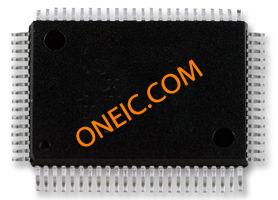MK30DN512ZVLK10
32-bit ARM Cortex M4 microcontrollers with 512KB flash memory
Manufacturer: ['freescale', 'nxp']
series introduction
# Introduction to the MK30DN512ZVLK10 Product Series
## 1. Overview
The MK30DN512ZVLK10 is a highly advanced and versatile microcontroller product series developed by NXP Semiconductors. It belongs to the Kinetis K30 family, which is well - known for its high - performance, low - power consumption, and rich peripheral integration, making it suitable for a wide range of applications in various industries.
## 2. Key Features
### 2.1 Processor Core
- **ARM Cortex - M4 Core**: The MK30DN512ZVLK10 is powered by an ARM Cortex - M4 processor core with a floating - point unit (FPU). This core offers a high level of computational performance, with a maximum operating frequency of up to 100 MHz. The FPU enables efficient handling of floating - point arithmetic operations, which is crucial for applications such as signal processing, control algorithms, and scientific calculations.
- **Thumb - 2 Instruction Set**: It supports the Thumb - 2 instruction set, which provides a good balance between code density and performance. This allows for more efficient use of memory and faster execution of instructions, reducing the overall system cost and improving the application's responsiveness.
### 2.2 Memory
- **Flash Memory**: It comes with 512 KB of on - chip flash memory. This large - capacity flash memory can store the application code, data, and configuration information. The flash memory has a high - endurance rating, which means it can withstand a large number of program - erase cycles, making it suitable for long - term data storage and firmware updates.
- **RAM**: The microcontroller is equipped with 128 KB of static random - access memory (SRAM). The SRAM provides fast access to data during program execution, allowing for efficient data processing and buffering. It can store variables, intermediate results, and stack information, ensuring smooth operation of the application.
### 2.3 Peripherals
#### 2.3.1 Communication Peripherals
- **UART (Universal Asynchronous Receiver - Transmitter)**: Multiple UART interfaces are available, which are commonly used for serial communication with other devices such as sensors, displays, and communication modules. UART provides a simple and reliable way to transfer data between the microcontroller and external devices, supporting various baud rates and data formats.
- **SPI (Serial Peripheral Interface)**: The SPI interface offers high - speed serial communication between the microcontroller and other SPI - compatible devices. It is often used for communicating with external memory chips, sensors, and actuators. The SPI interface supports multiple modes of operation, allowing for flexible configuration according to the requirements of the connected devices.
- **I2C (Inter - Integrated Circuit)**: The I2C interface is a widely used serial communication protocol for connecting low - speed devices such as sensors, EEPROMs, and real - time clocks. It uses a two - wire bus structure, which simplifies the hardware design and reduces the number of pins required for communication.
#### 2.3.2 Timers and Counters
- **PIT (Periodic Interrupt Timer)**: The PIT provides accurate and flexible timing functions. It can be used to generate periodic interrupts, which are useful for tasks such as time - based control, data sampling, and event scheduling.
- **TPM (Timer/PWM Module)**: The TPM module can be configured as a timer or a pulse - width modulation (PWM) generator. As a timer, it can measure time intervals and generate interrupts at specific time points. As a PWM generator, it can generate variable - width pulses, which are commonly used for motor control, LED dimming, and power management
Images for reference

80-LQFP

Image Preview

Image Preview